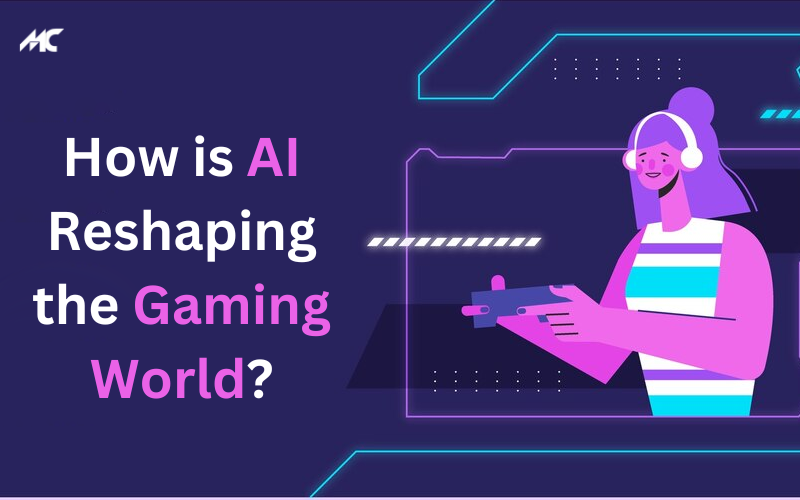In the ever-evolving landscape of the gaming industry, artificial intelligence (AI) has emerged as a transformative force, reshaping the way we play, experience, and interact with games. From sophisticated NPCs that exhibit human-like behaviors to dynamic environments that adapt to players' choices, AI has unlocked new dimensions of realism and immersion.
This technological leap has not only elevated the gaming experience but has also given rise to innovative game design possibilities, fostering a new era where virtual worlds feel increasingly alive and responsive. Within this paradigm, the synergy between AI and web 3.0 development services is particularly noteworthy, as it propels the gaming industry into a realm where decentralized, user-centric experiences become the norm.
What is AI in Gaming?
AI in gaming involves using artificial intelligence to enhance various aspects of video games, including realistic non-player character behavior, challenging opponent strategies, procedural content generation, dynamic difficulty adjustment, voice recognition, adaptive learning, simulation and physics, and decision-making models like behavior trees and finite state machines. These applications contribute to creating more immersive and engaging gaming experiences.
Must Read: Best Artificial Intelligence Software Development Tools
Evolution of AI in Gaming
The evolution of AI in gaming has seen significant advancements over the years, with developers incorporating increasingly sophisticated techniques to enhance the gaming experience. Here is a brief overview of the key stages in the evolution of AI in gaming:
Rule-Based Systems (1970s-1980s):
Early video games employed rule-based systems where developers coded specific instructions and behaviors for non-player characters. These systems followed predefined rules and lacked adaptability.
Scripted AI (1990s):
Games in the 1990s introduced scripted AI, where developers created predefined scripts to govern NPC behavior. While more dynamic than rule-based systems, scripted AI still lacked adaptability and responsiveness to player actions.
Finite State Machines (Late 1990s-2000s):
Finite State Machines (FSMs) became popular for modeling AI behavior. FSMs allowed characters to switch between predefined states based on specific conditions, providing more dynamic and context-aware actions.
Pathfinding Algorithms (1990s-2000s):
Pathfinding algorithms, such as A* (A-star), were widely adopted to improve NPC navigation within game environments. This enhanced the realism of character movement and exploration.
Behavior Trees (2010s):
Behavior trees became a popular method for designing AI in games. These hierarchical structures allowed developers to model complex decision-making processes, providing characters with more adaptive and nuanced behaviors.
Adaptive Learning and Player Modeling (2010s-Present):
AI in gaming started incorporating adaptive learning algorithms to understand and adapt to individual player styles. This personalization contributes to a more tailored and engaging gameplay experience.
Read: How Will AI Take Forward Mobile App Development In 2023?
Key Technologies Driving AI in Gaming
Machine Learning (ML):
ML algorithms enhance game development by providing personalized experiences, dynamic difficulty adjustment, and character behavior modeling.
Neural Networks:
Deep learning techniques, particularly neural networks, improve graphics, animation, and character interactions, contributing to more realistic and immersive gaming experiences.
Natural Language Processing (NLP):
NLP enables interactive communication between players and non-player characters (NPCs) using natural language, enhancing the overall gaming experience.
Reinforcement Learning (RL):
RL is used to train agents within games, allowing them to learn and improve decision-making over time. It's commonly employed for creating adaptive and challenging NPCs.
Procedural Content Generation (PCG):
AI-driven PCG is utilized to create diverse and dynamic game content, including levels, maps, and quests, improving replayability and reducing development time.
AI in Gameplay:
AI in gameplay enhances the gaming experience in several ways. It introduces realistic character behaviors to NPCs, enabling dynamic adaptation to changing in-game conditions and delivering engaging challenges to players. The implementation of dynamic difficulty adjustment ensures that the game adapts in real time to individual player skills, providing a tailored and enjoyable experience for users of varying proficiency levels.
In combat scenarios, AI plays a crucial role by controlling enemy behaviors, making adversaries more strategic and responsive. Through learning from player tactics, the enemy AI evolves, creating a dynamic and challenging combat environment. Additionally, the integration of procedural content generation (PCG) facilitates the creation of diverse and dynamic game content, such as levels, maps, and quests. This not only increases replayability but also reduces predictability, offering players unique experiences with each playthrough.
Must Read: How AI In Blockchain Can Improve Your Business Solutions
Conclusion:
In conclusion, the integration of AI in gaming has propelled the industry into a realm of unparalleled innovation. From its evolutionary journey to the present, AI has redefined gameplay, introducing adaptive algorithms and cutting-edge technologies. As we look ahead, the future promises even greater heights, with AI poised to create dynamic, personalized gaming experiences. The ongoing saga of AI and gaming ensures that the future holds captivating and unpredictable chapters, cementing the gaming world as a pioneer in technological advancements and immersive entertainment.






Comments